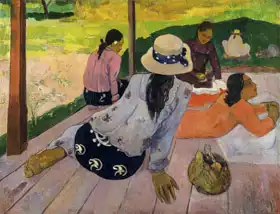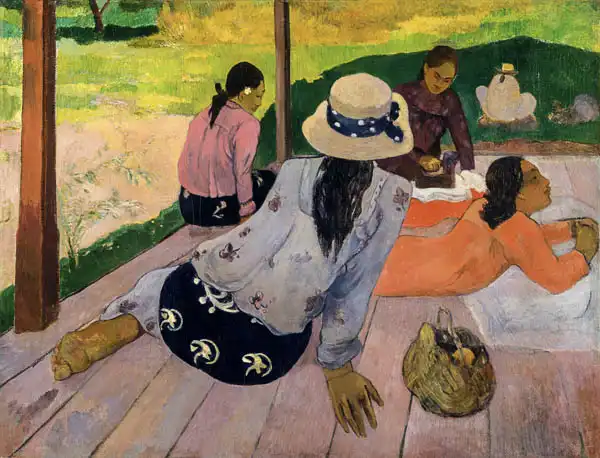About this finishing
Print. The image is printed on the top quality 10-ink HP Z9PS printer on HP matte 270 g / m2 paper. You can choose any size to an accuracy of 1 cm. A margin of 5 cm around the image is added to the size of the motif.


You can find a detailed description about our finishings
here.
Siesta
Date:
1891Medium:
oil on canvasLocation:
private collectionDimensions:
86 x 113"Siesta" by
Paul Gauguin is an oil painting painted around 1892. This painting is an expression of Gauguin's interest in exotic and primitive subjects, which was characteristic of his late period.
In the painting "Siesta" we see three figures in a relaxing moment. The scene depicts two
women , one sleeping on the grass while the other sits holding a fruit basket. The man in the background is shown with a musical instrument, perhaps a ukulele, which may refer to the atmosphere of Polynesian culture that Gauguin discovered during his stay in Tahiti.
Gauguin uses vivid colors and stylized shapes, which is characteristic of his
post-impressionist and
symbolist approach to painting. The painting "Siesta" captures Gauguin's desire to escape from modern civilization and search for simplicity and authenticity in other cultures.
Gauguin painted picture Siesta in 1891. Prevailing color of this fine art print is vivid and its shape is landscape. Original size is 86 x 113. This art piece is located in a private collection This image is printed on demand - you can choose material, size and finishing.
Eugène Henri Paul Gauguin (1848-1903). French painter and a leading figure of
Postimpressionism. His experiments with colour strongly influenced modern art of the early 20th century. As one of the first, he subscribed to primitivism: simplified and exaggerated contours of the body, strong and contrasting colours. This artistic style was partly due his admiration for the art of the primitive cultures of Africa, Micronesia and North American Indians. Gauguin himself had the opportunity to experience life on Tahiti, where he resided from 1891 until his death. It was in Polynesia that he created his most famous paintings.


